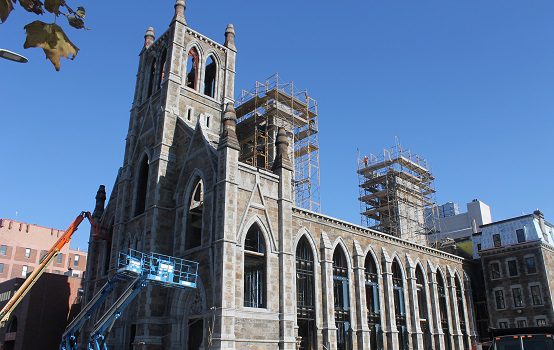From Chapels to Condos

At night it stands a silent and dark shadow against the glittering lights of Boston’s Back Bay, the only sound the almost riparian traffic on the Massachusetts Turnpike. Yet step closer and one sees that the edifice is not merely vacant, but hollow—a Gothic Revival skeleton that has given up the ghost.
This was the Roman Catholic Holy Trinity Church in the South End. It was closed amid controversy and in 2008, the Archdiocese of Boston sold it to developers who planned to remake it into 33 luxury condominiums. Renderings show a gutted interior with a modernist glass and steel structure erupting out of the stonework like a skin disease.
The initial controversy was about more than an historic loss: a Traditional Latin Mass community was displaced, and there was a perception that the archdiocese wanted to sell valuable land to pay legal costs related to the sex-abuse scandal of the time.
But the closure of historic urban houses of worship has as much to do with demographic trends originating decades ago—and the challenges of maintaining a building after decades of deferred maintenance—as it did with any scandal or decline in attendance.
Churches are intimately tied to their neighborhoods, especially in areas built before mass automobile ownership. In America’s cities, these ties often remain. In the 19th century, the connection was even more pronounced, as people of similar ethnic and religious backgrounds settled together for mutual aid and protection in a challenging, sometimes corrupt and hostile, urban environment.
The ethnic parishes of Catholic immigrants, for example, formed a nucleus where the traditions of the old country were passed down. The younger generation was discouraged from intermarriage, and old languages were preserved, in some cases into the 21st century. Parishioners, suspicious of public education in a Protestant country, formed their own schools and started societies to promote temperance, provide medical care, and pay for funerals and pensions for widows and orphans. The first credit union in the United States, St. Mary’s Bank in Manchester, N.H., was organized by a Catholic parish priest.
Holy Trinity was no different. The first parochial school in New England was organized by the parish, said church historian Robert Sauer, while German immigrants who heard Holy Mass there brought Christmas trees and cards to America and helped found the Boston Symphony Orchestra. Over its 164 years of existence, parishioners organized 22 religious sodalities and confraternities, an orphanage and old people’s home, charities devoted to the poor, Catholic missions around the world, and relief for the people of Germany and Austria after World War II.
Today, according to the nonprofit Partners for Sacred Places, churches and religious buildings of all faiths continue to have an economic impact on their neighborhoods. Their research found that almost all have some sort of community-service programs, and most have at least four running concurrently. The same study estimated that in Philadelphia alone religious congregations contribute over $100 million to their community annually—about $144,000 per congregation. Most of that comes from measuring volunteer time as though it were paid labor, but they also provide space, staff, and direct financial support to neighborhood services. Sixty percent of churches surveyed had food pantries, and nearly as many hosted music performances and clothing donations. Over 40 percent had soup kitchens.
While these activities can result in some sidewalk presence, contributing to neighborhood vitality and putting eyes on the street, churches interact with their neighborhoods differently than shops, restaurants, and residences.
“They give a sense of refuge or respite,” said Sara Joy Proppe, founder of the Proximity Project, a Minnesota group that seeks to involve congregations in urban planning. She said that a research agency, the Barna Group, found that while millennials say they go to suburban megachurches for anonymity, many are also drawn to older churches.
“The more traditional churches are located in urban centers, on smaller lots,” Proppe explained. “They’re very grand, but it’s done in a way that’s compatible at the human scale. I think that by default they do in some ways … provide more community interaction.”
Set among shops and residences, a traditionally designed church provides variety in the streetscape. Ecclesiastical architecture, whether the opulent medievalism of a Ralph Adams Cram or the white-painted wooden buildings of New England’s older Congregationalist and Unitarian churches, has a different telos and origin than secular architecture. Indeed, for Catholics, churches are literally consecrated spaces, set apart from ordinary use.
A church too involved with the outside world can lose its sense of the sacred. In Manhattan’s St. Patrick’s Cathedral, TV screens flank the sanctuary, other televisions in the vestibule loudly advertise tours, and glass gift shops hawk their wares. Unless there is a special Mass, tourists wander between the pews, taking snapshots with their phones. Street noise can drown out the choir. Far from an oasis of calm, the church invites into its sanctum the bustle from outside.
But when a parish closes, even worldly activity ceases and the neighborhood is left with an unusually adorned building.
After its 2008 closure, Holy Trinity was surrounded by fencing. Stained-glass windows were replaced with plywood. Practically overnight a living relic of the neighborhood’s history was turned into blight. In many ways, however, the church had outlived its purpose. As Sauer recounts, in the 1930s—long before controversial liturgical reforms of Vatican II in the 1960s or white flight in the 1970s—German families began moving away to more upscale neighborhoods or suburbs. The Catholics who moved in—mainly African-Americans, Syrians, and poor whites of various ethnicities—attended the nearby Cathedral of the Holy Cross. Holy Trinity remained tied to German-Americans, but they ultimately joined other parishes, only making the long trip to the South End on special occasions. Before 1960s urban renewal destroyed the neighborhood, much of the old neighborhood had already left Holy Trinity.
While not mourned as much as that of Boston’s West End, urban renewal in the South End was no less destructive. According to Sauer, 700 families in the Castle Square neighborhood adjacent to Holy Trinity were displaced when the city bulldozed their homes in 1961. Also destroyed were the parish’s convent, schools, orphanage, and old-age home. While Castle Square was eventually rebuilt as public housing, another nearby section, New York Streets, was turned into superblocks designed to attract factories. They didn’t. As recently as 2012, there was little more than a few warehouses, a Chinese supermarket, and the Boston Herald printing plant.
A church closure not only deprives a neighborhood of numerous social benefits, but can rob it of its cultural and artistic heritage. A Catholic parish, for example, will be stripped of everything not totally immobile. Stained glass, altars, tabernacles, statues, candlesticks, crucifixes, communion rails, lamps, pews, and bells are removed. Some dioceses maintain warehouses to store the items in case they are needed by another church. A church demolition allows for even more ambitious dissolution: as Anatole Upart relates in Sacred Architecture, the front façade of Chicago’s Saint John of God Catholic Church was taken apart and rebuilt as part of Saint Raphael the Archangel in Old Mill Creek, Ill.
Catholic schools also contributed to social cohesion. According to the Rev. John A. Coleman S.J., neighborhoods in Chicago where parish schools remained open had 33 percent less crime than places where they closed. “It is not just the inner social capital of Catholic schools (discipline, parental involvement, teacher dedication) that counts but that this social capital has a spillover effect on neighborhoods,” he wrote in America.
“To tear them down would be to … lose established value,” said Kathy Kottaridis, the executive director of Historic Boston Inc., a nonprofit that redevelops historic buildings in Boston. HBI once ran a program helping congregations keep their churches open with financial education and grant applications, but it was discontinued because simply maintaining buildings did not address declining attendance or overcome poor leadership. “It was pushing the boulder up the hill,” Kottaridis said.
But repurposing a historic church is challenging. Removing them from service opens them up to taxation, maintenance issues remain, and structures with landmark status might be required to go through extra design review or use historically accurate materials. Buildings not compliant with local codes have to be brought up to date—many churches need new heating systems, roof repairs, and updated electrical wiring. In cities like Boston, neighbors also have a large say in redevelopment plans.
Notwithstanding these challenges, historic churches across the Boston area have been repurposed for a variety of uses. The Massachusetts Preservation Coalition and the National Trust for Historic Preservation report that churches have been converted into theaters, affordable housing, market-rate apartments and condos, mixed-use buildings, commercial space, offices, schools, and community centers.
In Quebec, which is even more post-Christian than Boston, religious properties are being sold at “an alarming rate,” reported the Toronto Star. There are so many going on sale that projects that would likely not even be considered in the United States get the go-ahead. One church has been turned into an indoor miniature golf course, while another is now a rock-climbing gym, and a third has become the Quebec Circus School.
One thing most people agree on is that conversion to secular use is better than demolition.
 “If we don’t try to come up with plans to try to reuse these buildings … society would be poorer as a result,” Lyne Bernier, the chair of research on Canada’s urban heritage at the University of Quebec at Montreal told The Star.
“If we don’t try to come up with plans to try to reuse these buildings … society would be poorer as a result,” Lyne Bernier, the chair of research on Canada’s urban heritage at the University of Quebec at Montreal told The Star.
“It’s a viewpoint that’s not strictly philosophical,” Kottaridis said.
And yet future generations may come to miss the stability their grandparents felt stifled by. They may one day lament, as Evelyn Waugh observed in the novel Brideshead Revisited, that “suddenly there wasn’t any chapel there anymore, just an oddly decorated room.”
Meanwhile, the preservation movement ensures that some church buildings will still be there, waiting for their next act.
Matthew M. Robare is a freelance journalist based in Boston. This article was supported by a grant from the Richard H. Driehaus Foundation. Follow New Urbs on Twitter for a feed dedicated to TAC’s coverage of cities, urbanism, and place.